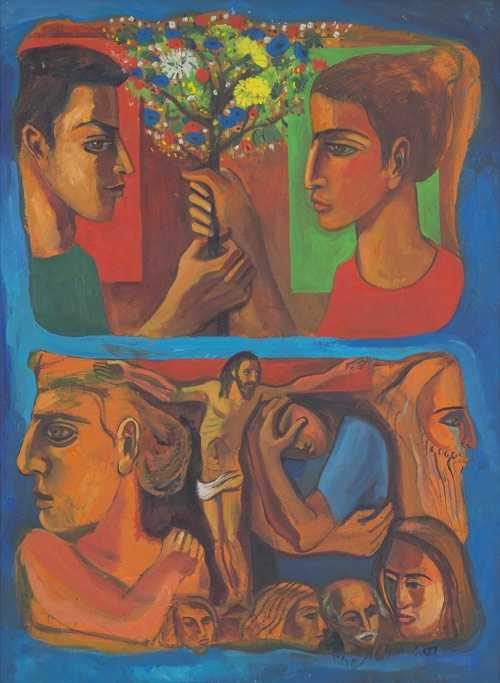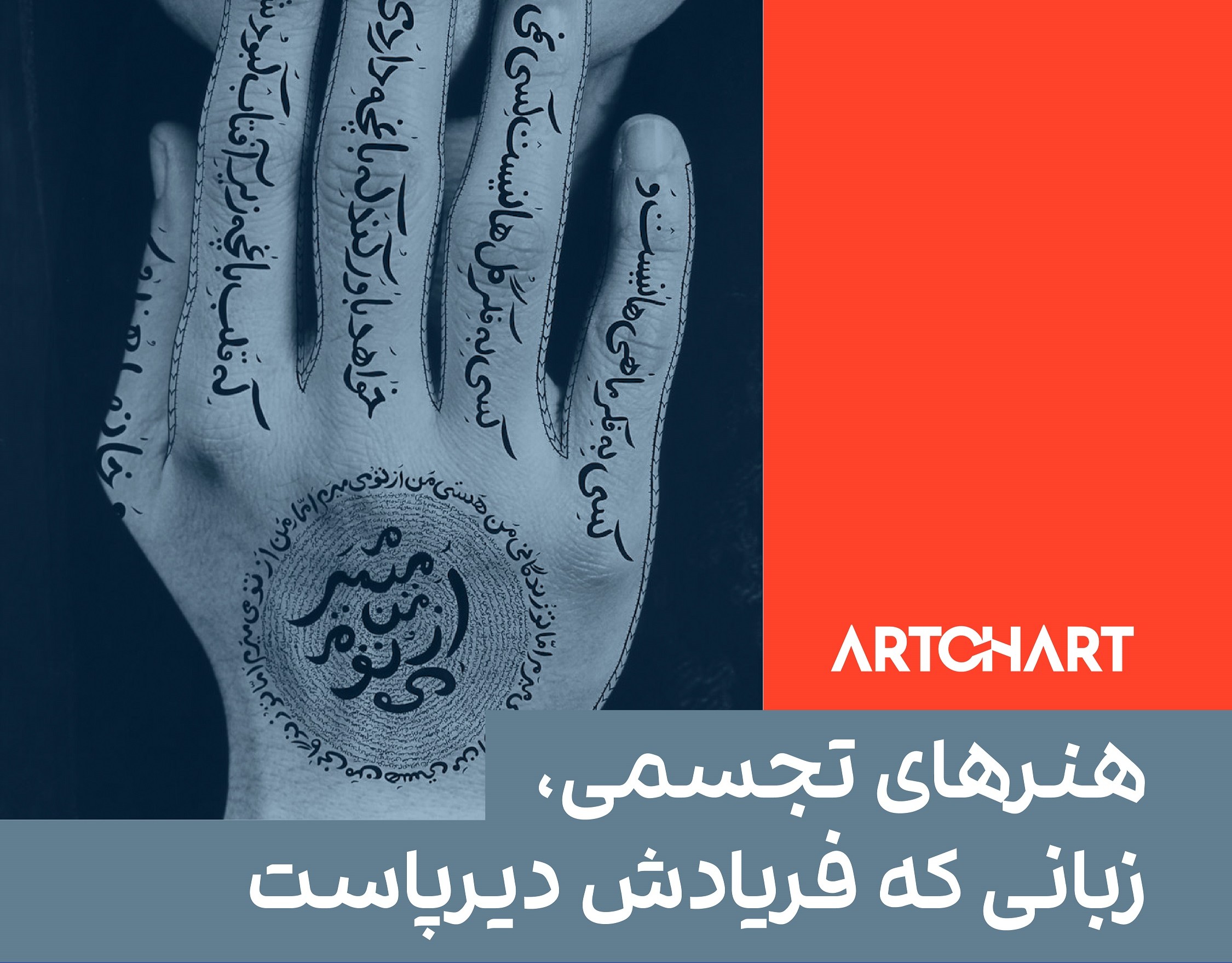About Hannibal Alkhas
Hannibal Alkhas’s paintings have a kind of narrative expressionism that is formed on the basis of mythological, religious and social themes. Alkhaz was undoubtedly one of the most influential and influential teachers of modernism in Iran. Alkhas loved poetry and literature and was himself a writer and a member of the Writers' Association of Iran. In the 1970s, he wrote art criticism for the Kayhan newspaper. He later published a collection of these critiques, memoirs, and other writings in his book “Open with the Sun”.
Hannibal alkhas was born in an Assyrian family in Kermanshah. He has been interested in painting since he was a child and has drawn cartoons for magazines such as Towfigh. After immigrating to Tehran, he learned the basics of painting from Jafar Petgar. He had little interest in the academic style of painting, nor did he have much success in this style of work due to the vibration of the handle. At the same time, he was influenced by the coffee house paintings, which were up-to-date, and turned to the expressive features of this style. Alkhaz left for the United States to continue his education in philosophy and mathematics at Loyola University in Chicago. He then went to the Art Institute of Chicago, where he earned his bachelor's and master's degrees in art. After graduating in 1959, he returned to Iran and exhibited collections of his works in the Iran-US Association and the Reza Abbasi Museum. Two years later, he established the Gilgamesh Gallery in Tehran. Gilgamesh played an important role in supporting the new generation of modern artists. Pilaram, Borujeni, Dadkhah, Mahmoud Zanganeh, etc. were among the artists who were introduced to the Iranian artistic community through Gilgamesh Gallery. In the post-revolutionary years, he was travelling between Iran and the United States and taught painting.
Hannibal Alkhas figurative paintings form an important part of the experiences of modern Iranian art. This Assyrian artist combined the narrative of Iranian art with mythical allegories and used expressive atmospheres to give his works a distinct identity. "... From the mid-1960s, he turned to more complex combinations with bright colors and sometimes with explanatory writings,” Ruyin Pakbaz writes about special works. “Ancient myths, Assyrian and Achaemenid reliefs, Christian icons, murals by Mexican masters, and Gauguin's paintings inspired him. He was very interested in literature, especially modern poetry, and created a number of his paintings based on the poems of Nima, Shamloo, Forough and others."
In Alkhas’s paintings, humans have a constant and frequent presence. "I used to go to live modeling classes to paint," he says. It was in that class that I did my first mental work. It was a mental work full of human faces. "Imaginations were mostly about works that had human limbs and human faces, but the first time I kept a theme in my work and repeated it, and later it became the signature of my work, it was the abundance of people."
Hannibal Alkhas' first appearance in the auctions dates back to June 2013 in Tehran.
Hannibal alkhas was born in an Assyrian family in Kermanshah. He has been interested in painting since he was a child and has drawn cartoons for magazines such as Towfigh. After immigrating to Tehran, he learned the basics of painting from Jafar Petgar. He had little interest in the academic style of painting, nor did he have much success in this style of work due to the vibration of the handle. At the same time, he was influenced by the coffee house paintings, which were up-to-date, and turned to the expressive features of this style. Alkhaz left for the United States to continue his education in philosophy and mathematics at Loyola University in Chicago. He then went to the Art Institute of Chicago, where he earned his bachelor's and master's degrees in art. After graduating in 1959, he returned to Iran and exhibited collections of his works in the Iran-US Association and the Reza Abbasi Museum. Two years later, he established the Gilgamesh Gallery in Tehran. Gilgamesh played an important role in supporting the new generation of modern artists. Pilaram, Borujeni, Dadkhah, Mahmoud Zanganeh, etc. were among the artists who were introduced to the Iranian artistic community through Gilgamesh Gallery. In the post-revolutionary years, he was travelling between Iran and the United States and taught painting.
Hannibal Alkhas figurative paintings form an important part of the experiences of modern Iranian art. This Assyrian artist combined the narrative of Iranian art with mythical allegories and used expressive atmospheres to give his works a distinct identity. "... From the mid-1960s, he turned to more complex combinations with bright colors and sometimes with explanatory writings,” Ruyin Pakbaz writes about special works. “Ancient myths, Assyrian and Achaemenid reliefs, Christian icons, murals by Mexican masters, and Gauguin's paintings inspired him. He was very interested in literature, especially modern poetry, and created a number of his paintings based on the poems of Nima, Shamloo, Forough and others."
In Alkhas’s paintings, humans have a constant and frequent presence. "I used to go to live modeling classes to paint," he says. It was in that class that I did my first mental work. It was a mental work full of human faces. "Imaginations were mostly about works that had human limbs and human faces, but the first time I kept a theme in my work and repeated it, and later it became the signature of my work, it was the abundance of people."
Hannibal Alkhas' first appearance in the auctions dates back to June 2013 in Tehran.
The Most Expensive Artwork
At Auctions
First Attendance
28 May 2013
# Attendance
21
# Artworks
21
Average Realized Price
11,202 USD
Average Min Estimate
7,562 USD
Average Max Estimate
10,609 USD
Sell-through Rate
95.238%
Average Growth of Artwork Worth
18.202%
Timeline
The 24th Tehran - Contemporary Iranian Art auction
3 October
Charsoo exhibition
5 September
Artibition Auction - july 2025 auction
11 July
Shadow exhibition
18 April
The 22nd Tehran - Modern, Classic and Traditional Iranian Art auction
14 February
Modern and Contemporary Collector exhibition
7 February
Timeless Creation exhibition
25 October
A Selection of Works Less than 200 Million Tomans exhibition
19 September
The Pioneers of Modern Iranian Art Vol.3 exhibition
24 August
Resize exhibition
16 August
"Bitter, Sweet, Burden" Iranian Perspective, Three Views exhibition
9 August
Decades Projects 1300-1310 exhibition
2 August
Contemporary Art Collector exhibition
28 June
10s of Artworks, 10s of Millions exhibition
8 March
Art Advisory exhibition
8 March
New Year/ New Vision exhibition
23 February
The Artwork of Legendary Artists exhibition
9 February
The 19th Tehran -Classic and Modern Iranian Art auction
24 January
Gozar Project exhibition
19 January
Modern Collectore exhibition
19 January
Conversation exhibition
12 January
Border exhibition
27 October
Collector - Modern exhibition
29 September
A Selection of 70 Years of Iranian Sculpture exhibition
4 August
Annual Amordad 1402 exhibition
4 August
Figure exhibition
23 June
resize exhibition
13 April
Woman exhibition
13 December
Lotfi x Mashahir Cross 2 exhibition
9 September
Art Closer Than Ever exhibition
26 August
Resize exhibition
13 May
Nowruz Festival of Rivers exhibition
10 March
The First Fertile Element exhibition
18 February
Opportunity exhibition
13 February
Gaze it exhibition
11 February
Mirror reflections exhibition
19 January
The 15th Tehran- Modern Iranian Art auction
14 January
10th Collector exhibition
7 January
Annual Amordad 1400 exhibition
10 September
No.9 auction
3 September
EJ's Autos, Fine Art & Collectibles auction
10 April
The 13th Tehran- Modern and Contemporary Iranian Art auction
15 January
No.8 auction
1 January
No.6 auction
16 October
Collector 6 exhibition
18 September
Archive exhibition
21 August
One by One exhibition
3 July
No.4 auction
9 June
Modernism auction
23 May
No.3 auction
23 April
+98 exhibition
21 February
دوازدهمین دوره حراج تهران auction
17 January
White Black Gray exhibition
13 December
No.1 auction
15 November
When the Bird Died exhibition
21 June
دهمین دوره حراج تهران auction
11 January
The Color of the Sky exhibition
30 November
Notebook exhibition
19 October
When the Bird Died exhibition
28 September
Summer Sale of Artibition exhibition
7 September
The 9th Tehran- Classic and Modern Iranian Art auction
29 June
+۹۶ exhibition
16 February
هشتمین دوره حراج تهران auction
12 January
"Still Life" Amordad Annual exhibition
4 August
Group exhibition exhibition
30 September
پنجمین دوره حراج تهران auction
27 May
Annual Amordad 94 exhibition
14 August
چهارمین دوره حراج تهران auction
29 May
دومین دوره حراج تهران auction
28 May
Articles
Visual arts, a durable scream 17 November 2022
At this historical moment, art, like all fields, has faced fundamental questions: What is the mission of the artist in relation to political and social struggles? Or, basically, what is the relationship between art and struggle? When we specifically think about visual arts and consider the specific possibilities and limitations of this field of arts, questions like this take on a mo...

